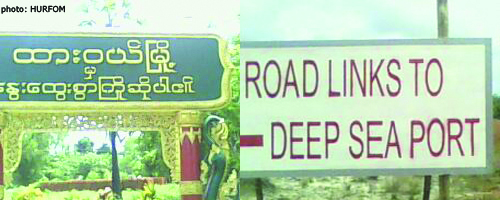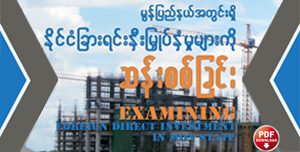Land Survey Department research near Tavoy spark fears of impending land confiscation
January 18, 2011
In early January representatives from the local land-surveying department in Tennaserim Division, visited villages that fall within the project area of Thai-Italian Development Company’s slated Tavoy deep-sea port project. While only preliminary information has been collected, residents see the research as a warning sign of the imminent seizer of their land. Without compensation the livelihoods of Tavoy’s landowners would be destroyed, and already, there are indications that the numbers of residents fleeing the area for migrant work in Thailand, has increased.
On January 8th, 2011, local authorities from the State Peace and Development Council (SPDC) military government started the collection of ownership lists, of houses, plantations, and paddy fields that are owned by local civilians within the area in which the Tavoy deep-sea port will be constructed. These areas currently visited by local authorities include villages north-west of land already surveyed and designated as the site for the project’s Upstream and Downstream Petrochemical Complex. These visits have caused fear amongst local communities that they will face land confiscation and absent or nominal compensation in the coming months. Communities are not new to the threat, as already so called development projects have seen the loss of villager land to railroad construction in 1995 to 1998 and the Yadana and Yetagun gas pipelines in 1999 to 2003.
At 10:00 AM on the 8th, U Aung Su, 55, a Ba-Gaw-Sone villager, was visited by a group documenting land ownership. The collection of ownership lists was done by four groups, with six members – the general administrator of the Township Peace and Development Council (TPDC) office and specific regional officers of the Land Surveying Department. U Aung Su explaining that the authorities have surveyed his 12 acre perennial plantation near Ba Gaw Sone village on the road to Long Lone town. These groups detailed the crops, land size, and asked that the civilian land owners asses the value of the land and provide them with a price for compensation for the land’s current value. While the group did not know if land would be confiscated with or without compensation, U Aung Su described a significant fear amongst local residents that no compensation would be provided:
They asked in detail if [I] posses any house or plantation. We cultivated oil palms at our plantation in the past but now we cultivate cashew nuts, pineapple and on the rest of the land, one thousand rubber plants are cultivated. The cultivation has already gone on for five years. They ordered me to assess the current value [of my plantation]. I said that my plantation values over 30 million [kyat]. I speak frankly, [saying] that after I had heard that the Thai [company] would construct the deep-sea port and the industrial zone since one and half years ago, I wished that [the] project [would] not to come true. However, the nightmare comes true now. I depend on my perennial plantation for my life. I am not skilled in other work. My children also…rely on this plantation. We can do nothing even if the plantation is confiscated. I have already realized that if seized by the government, the compensation [for the plantation] will be very little as [it will be] the government’s price. As an ordinary civilian, I have suffered from depression because my property was [put on the] list [by the authorities]. Now, it seems the confiscation will really occur.
On January 9th a cultivator from Yebu Township confirmed that township authorities and the local land-surveying groups had been working to collect ownership lists of the locals who live in the area of Tavoy deep-sea port project. A 47-year-old Nyaung Pin Seit villager of Yebyu Township, Tenasserim Division, and who owns 7 acres of cashew-nut plantation, describes the breadth of the project, and the little hope people have for receiving full compensation for their land:
Yes, that group [that visited] said that [the purpose of] the visit was collecting an ownership list for their records. We asked whether the land will be confiscated or not, but [they replied] they knew nothing. As is their duty, they mainly recorded the land ownership, the guarantee of the house, the kind of plants cultivated in the plantation, and the approximate current value [of the land]. Due to that [list] collection, we feel awkward. My plantation [cultivates] perennial cashew nut plants; but, I can’t decide whether to continue my cultivation or neglect my plants. I am not enthusiastic to continue my work because I know [my plantation] will be confiscated one day. In this region, cashew nuts are the first choice to cultivate and the second most popular is rubber plants. If the land [already surveyed] is counted in acres, the number [must already] reach up to ten thousand. As I knew from the list of a land-surveying clerk, each owner owns between five to over thirty acres; therefore there are a lots of acres of land. In this region, especially in Padat, Lae Young, Nyaung Pin Seit, Pain Shaung, Kyauk Hwat Gone, and Muduu villages…we have made an investment for a long time and now we have to give up [our plantations] for this project, so everyone can easily sympathize with the owners. We can’t hope that the compensation will be a great amount [for our plantations]. Even if the Thai company gives a big amount [for payment], after passing through the government, we will get only a very little amount. We have already had experience in the case of the French gas pipeline compensation 15 years ago. The company gave nearly full compensation but the government appropriated [the money] and we got only one-fifth of the value of our property. Therefore, the people in this region don’t believe in the promises of the government for providing compensation.
According to a land inventory list of the Italian-Thai Development Company retrieved by HURFOM, the contract which has been awarded to construct the Tavoy deep-sea port and the industrial zone, indicates that 28 villages in Tavoy, Yebyu and Longlone Townships of Tavoy District will be included in the project area. However, according to information from the Tavoy Township Land Surveying Department, amongst these villages, 20 so far have been measured and marked our for inclusion in the project. These numbers do not include villages that will be impacted by the at least 50 foot wide 160 km transportation corridor intended to connect Tavoy to the Thai border checkpoint of Phu Nam Ron. A Tavoy resident employed working for the land surveying department who preferred to remain anonymous, noted the scale of the project:
Most of the villages have to be moved entirely because the main project area will occupy about one hundred square miles…. In total, approximately 28 villages have to be moved for sure. Moreover, for the road and railway, [it will run] from Na Bu Lae village where the project will be started to [the] Thai border, [so] other villages will be impacted.
According to a Mon man, 35, who works as a Burmese-Thai interpreter for the Thai engineer group from Italian-Thai Development Company in the main project area of deep-sea port of Tavoy District, from the middle of 2010 to the middle of 2011, discussions of the project have indicated that 19 of the villages that are located in the area of the main project of the deep-sea port will be moved in 2011. The interpreter described how, in order to decrease the compensation rate to the possible lowest amount that the Italian-Thai Development Company would have to pay, the proposal for land acquisition was presented to the Burmese military government. By going through the military, land could be acquired in bulk at a discounted price, rather then going to land owners and buying land directly at the prices the owners request.
U Tun Ya, 60, and cultivator who is a resident of Na Bu Lae village, Yebyu Township, described the trend of economic development projects implemented in the area doing little to benefit local communities, and significant negative impacts on communities that result:
Whatever project is implemented, we are the persons who suffer. In this region, over the 20 year period of this military government, the railways, the roads and the French gas pipeline were built [supposedly] for this country’s development. Wherever the project was implemented, the civilians were [driven to] rock bottom. Only the foreigners who cooperated with the government have benefited from the development. As a result, we have declined from our original lives and have become paupers. This project will mirror the old events. We have to move from our places and work like a slaves in a foreign country. The process will happen in this way. Nothing is different.
A border based specialist on migration issues noted that during January while the government has started the collection of ownership lists for the Tavoy deep-sea port, increasing numbers of young people have been leaving from villages of Tavoy, Yebyu, and LongLone Township of Tenasserim Division, to work as migrant laborers in Thailand.
I am not sure if they have been fleeing [to Thailand] in advance due to this Tavoy deep-sea port [project]. However, the number of illegal immigrants is more than in the past. It is possible that they have been fleeing in large numbers because the weather is good enough to travel and the Thai authorities [are now] allowing them to make work permits again in early January;…[In any case], many young people from the villages in the main area of this deep-sea port [project] have been found [amongst people fleeing]. Now, beside me, Tavoyans from Maung Mae Shaung, Ya Line and Na Bu Lae [regions] are talking with agents to enter Thailand.
According to reports form other sources, such as the Independent Mon News Agency (IMNA), some communities have already been moved off their land west of the current land surveying effort, and have received compensation from private investors from Rangoon buying up beachfront properties. However, despite apparent rise in land prices that IMNA notes, compensation of 400,000 to 500,000 kyat paid to land owners remains well below what communities would need to successfully relocate and begin new lives[1].
As one of the most crucial steps in the construction of Thai-Italian’s Tavoy deep-sea port project, the acquisition of land for the project will have a major impact on the lives of residents in the area. Though billed as a development project that will benefit the local economy and the region, representatives from Italian-Thai indicate that the projects feasibility lies around communities’ lack of opportunity to seek recourse for poor compensation, compared to those in Thailand[2].
Communities are wholly dependent on their ability to cultivate crops of rice paddy, rubber and cashews. Without compensation that would allow these cultivators to begin new crops elsewhere, Thailand will likely see a larger number of migrant laborers arriving, as well as Internally Displaced Persons (IDP) camps located along the Thai-Burma border. It is important that before this happens, communities are paid fair compensation for the land and provided with opportunity to learn about their rights and options when approaching companies to negotiate the compensation provided for land.
[1] For information concerning land already bought near Tavoy from private investors, please see IMNA’s article here at http://monnews.org/?p=1531
[2] Comments by Anan Amarapala, vice president of the marine division, indicate that Thai-Italian is aware that Burmese communities will have no opportunity to fight land compensation prices, as compared to Thai communities. The specific comment to the New York Times can be found here, at http://www.nytimes.com/2010/11/27/world/asia/27iht-myanmar.html?pagewanted=2&_r=2&sq=myanmar&st=cse&scp=6 [SURVEYS 2]
Comments
Got something to say?
You must be logged in to post a comment.




















































